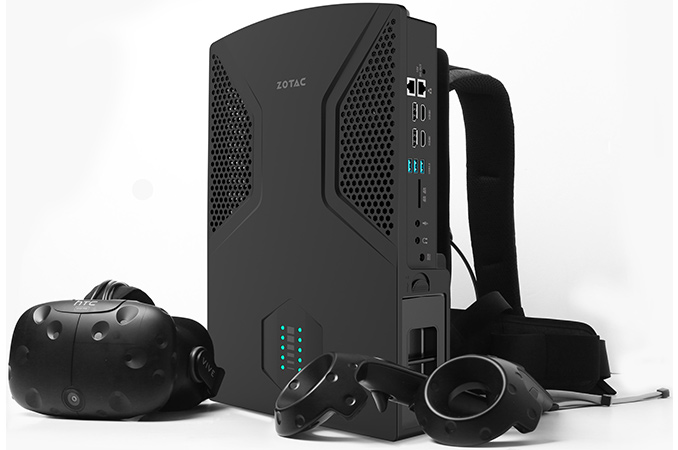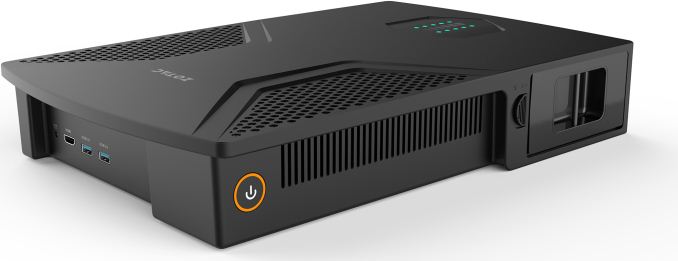ZOTAC VR GO Backpack PC Gets Priced: Core i7-6700T, GeForce GTX 1070, $1999
by Anton Shilov on November 30, 2016 2:00 PM EST
ZOTAC this week plans to start sales of its VR GO backpack PC designed for virtual reality enthusiasts. The system uses a quad-core processor from Intel, and is equipped with NVIDIA’s GeForce GTX 1070 graphics processor and comes with I/O capabilities, just like any normal desktop. The manufacturer plans to sell only fully configured VR GO backpacks for $1999, but the PCs can be upgraded by end-users themselves in a bid to meet their requirements.
ZOTAC formally introduced its VR GO backpack PC earlier this month, but kept the final specifications under wraps. This week, the company revealed that the system will feature Intel’s Core i7-6700T CPU, NVIDIA’s GeForce GTX 1070 GPU with 8 GB of GDDR5 memory (MXM module), 16 GB of DDR4-2133 RAM as well as a 240 GB M.2 SSD with PCIe 3.0 x4 interface from an undisclosed supplier. End-users can then upgrade the VR GO machines with a 2.5” SATA SSD (obviously, nobody wants a hard drive in a backpack PC due to extreme failure risks) as well as install up to 32 GB of DRAM. In theory, the CPU and the GPU could be swapped for higher-performance parts, but since the proprietary low-profile air cooling system was designed with the particular components (the i7-6700T and the GTX 1070) and TDP (150W) in mind, such upgrade would be considerably trickier.
Meanwhile, I/O capabilities of the ZOTAC VR GO are clearly worth a mention as the system has an HDMI 2.0 output as well as two USB Type-A ports on top to connect a VR headset as well as four additional USB 3.0/3.1 Type-A ports, four display outputs (two HDMI 2.0, two DP 1.3), an 802.11ac Wi-Fi + BT 4.2 module, two GbE ports, an SD card reader as well as two 3.5-mm audio jacks.
| ZOTAC VR GO Specifications | |
| ZBOX-VR7N70-W2B/W4B-BE/J/U/K | |
| CPU | Intel Core i7-6700T 4 cores/8 threads |
| PCH | unknown 100-series |
| Graphics | NVIDIA GeForce GTX 1070 2048 stream processors 128 texture units 64 ROPs 256-bit memory interface 8 GB of GDDR5 8 GT/s memory |
| Memory | Two SO-DIMM slots 16 GB DDR4-2133 installed compatible with up to 32 GB of DDR4-2133 |
| Storage | 240 GB M.2/PCIe SSD + one extra 2.5"/SATA bay |
| Wi-Fi | 802.11ac + BT 4.2 |
| Ethernet | 2 × GbE ports (Realtek) |
| Display Outputs | 3 × HDMI 2.0 2 × DP 1.3 |
| Audio | 3.5 mm audio in and 3.5 mm audio out |
| USB | 6 × USB 3.0 Type-A (5 Gbps) |
| Other I/O | DC12V-out for HTC Vive |
| Dimensions | 410 mm × 270 mm × 76 mm 16.14 × 10.63 × 2.99 inches |
| Weight | update: 4.95 kilograms |
| PSU | External |
| Batteries | 2 batteries, rated at 95Wh, 6600mAh |
| OS | Windows 10 Home |
| Price | $1999.99 |
The ZOTAC VR GO can work autonomously for two hours (obviously, the figure depends on applications used) on two Li-ion batteries rated at 95Wh (6600mAh). The batteries can be hot-swapped and charged separately. When not in use as a backpack to play virtual reality games, the VR GO can be used like a normal desktop computer: its form-factor allows it to be placed on a desk either vertically or horizontally and all the ports will remain accessible.
ZOTAC will sell its VR GO backpack PC with Windows 10 Home for $1999 in the U.S. The MSRP of the system is similar to the price of MSI’s VR One backpack computer that became available earlier this month. Each system has its own set of peculiarities, which is good as we see a competition in an emerging segment. For example, ZOTAC’s VR GO for $1999 has the GeForce GTX 1070 GPU, whereas a comparable MSI’s VR One 6RD comes with the GeForce GTX 1060. On the other hand, MSI’s machine has a Thunderbolt 3 port and comes with Windows 10 Pro, whereas ZOTAC’s backpack has a desktop-friendly form-factor and more I/O ports, but uses Windows 10 Home. To sum up, VR enthusiasts now have at least two models of backpack PCs to choose from. Meanwhile, both are quite expensive for niche PCs.
Source: ZOTAC

















14 Comments
View All Comments
Samus - Thursday, December 1, 2016 - link
For $2000 it should really include an HTC headset. I mean $2000 for a midrange gaming PC!? There isn't much more than $1000 in hardware in there.$250 CPU
$400 GPU
$80 motherboard
$70 SSD
$70 RAM
$50 chassis
$30 cooling system
$50 PSU
$30 batteries x2
fanofanand - Thursday, December 1, 2016 - link
This will be fantastic for all of the virtual Sherpa games coming out.caleblloyd - Monday, December 5, 2016 - link
In a Virtual Reality war game, this could literally be your rucksack. Attach some sandbags to it for a more realistic weight experience. Now all the game needs to do is ship with a 27.6lb M240B controller complete with an extra barrel, 1,000 rounds of linked plastic 7.62×51mm, and you're all set to go on a patrol!Drake123 - Wednesday, September 5, 2018 - link
A great device for virtual reality! Personally, I bought a virtual reality helmet oculus rift for my PC. I had a graphics card gtx 1070. But the power of this video card was not enough for a quality display of the virtual world. So I bought a more expensive video card (gtx 1080ti). But using only a helmet of virtual reality for VR games does not allow you to get the maximum of positive emotions from the virtual reality. Therefore, I often visit the center of virtual reality in Melbourne - https://virivr.com.au/. In this club, there is a lot of additional equipment that allows you to completely immerse in a virtual world.